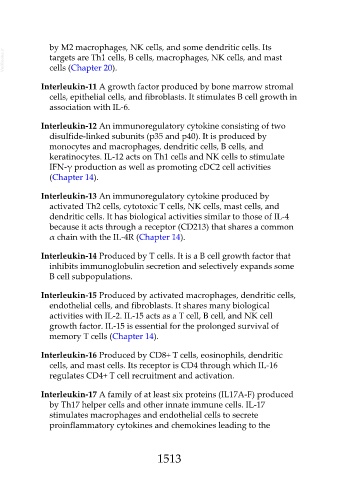Page 1513 - Veterinary Immunology, 10th Edition
P. 1513
by M2 macrophages, NK cells, and some dendritic cells. Its
VetBooks.ir targets are Th1 cells, B cells, macrophages, NK cells, and mast
cells (Chapter 20).
Interleukin-11 A growth factor produced by bone marrow stromal
cells, epithelial cells, and fibroblasts. It stimulates B cell growth in
association with IL-6.
Interleukin-12 An immunoregulatory cytokine consisting of two
disulfide-linked subunits (p35 and p40). It is produced by
monocytes and macrophages, dendritic cells, B cells, and
keratinocytes. IL-12 acts on Th1 cells and NK cells to stimulate
IFN-γ production as well as promoting cDC2 cell activities
(Chapter 14).
Interleukin-13 An immunoregulatory cytokine produced by
activated Th2 cells, cytotoxic T cells, NK cells, mast cells, and
dendritic cells. It has biological activities similar to those of IL-4
because it acts through a receptor (CD213) that shares a common
α chain with the IL-4R (Chapter 14).
Interleukin-14 Produced by T cells. It is a B cell growth factor that
inhibits immunoglobulin secretion and selectively expands some
B cell subpopulations.
Interleukin-15 Produced by activated macrophages, dendritic cells,
endothelial cells, and fibroblasts. It shares many biological
activities with IL-2. IL-15 acts as a T cell, B cell, and NK cell
growth factor. IL-15 is essential for the prolonged survival of
memory T cells (Chapter 14).
Interleukin-16 Produced by CD8+ T cells, eosinophils, dendritic
cells, and mast cells. Its receptor is CD4 through which IL-16
regulates CD4+ T cell recruitment and activation.
Interleukin-17 A family of at least six proteins (IL17A-F) produced
by Th17 helper cells and other innate immune cells. IL-17
stimulates macrophages and endothelial cells to secrete
proinflammatory cytokines and chemokines leading to the
1513

